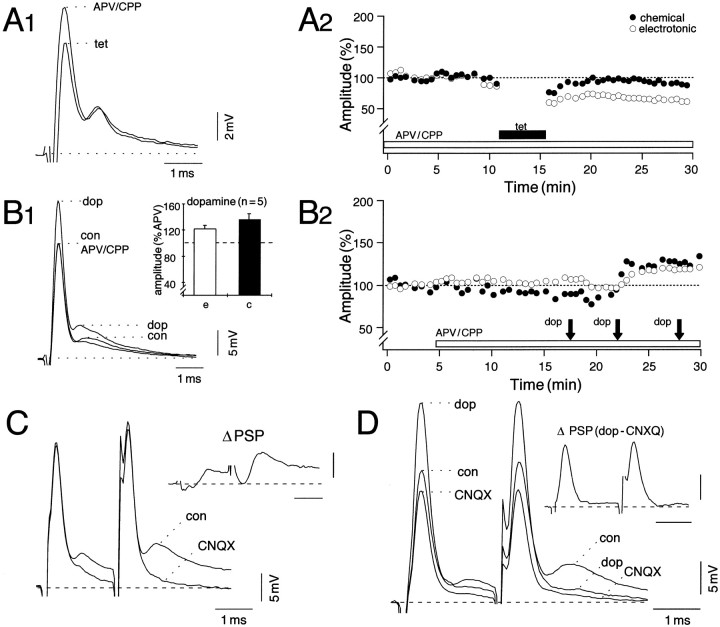Fig. 6.
Dopamine-evoked potentiation of the AMPA receptor-mediated component. A1, A2, Averaged traces (A1) and the time course of changes in evoked NVIII responses (A2) before and after tetanization from a preparation continually superfused with saline containing APV and CPP (50 μm each) to block NMDA receptor activation. B1, B2, In the presence of the blockers, dopamine still produced a potentiation; the same format was used as in A1 and A2, respectively. The third dopamine application in B2confirms a saturating potentiation evoked by the amine.Inset, B1, Pooled data from five experiments showing modest potentiations of the mean response amplitudes of electrotonic coupling potential (e) and the chemically mediated EPSP (c) after dopamine (100% equals the average of corresponding values in APV/CPP). The mean (μ) dopamine-evoked potentiations (±SEM) in the presence of APV/CPP [μ(e) = 22 ± 7%; μ(c) = 36 ± 8%; n = 5] did not differ significantly (p > 0.05) from control experiments [μ(e) = 37 ± 7%;μ(c) = 38 ± 6%;n = 6]. C, D, Effects of the non-NMDA receptor antagonist, CNQX, on NVIII-evoked responses in control (C) and subsequently after the application of dopamine (D). Synaptic facilitation produced by paired NVIII stimuli is used to illustrate the drug effects more clearly. C, Superimposed averages (n = 15) in control (con) and 15 min after superfusion of the brain with saline containing 50 μm CNQX. Note that the antagonist blocked most of the chemical EPSP, whereas the electrotonic coupling potential essentially was unaffected. D, In the presence of CNQX, dopamine substantially potentiates electrotonic coupling, but not the chemical EPSP. Insets, Digitally subtracted differences (Δ PSP) of the indicated responses showing the effect of CNQX on the chemical EPSP in control and showing dopamine-mediated enhancements of the coupling potential in the presence of CNQX. Calibrations are as for synaptic responses.

